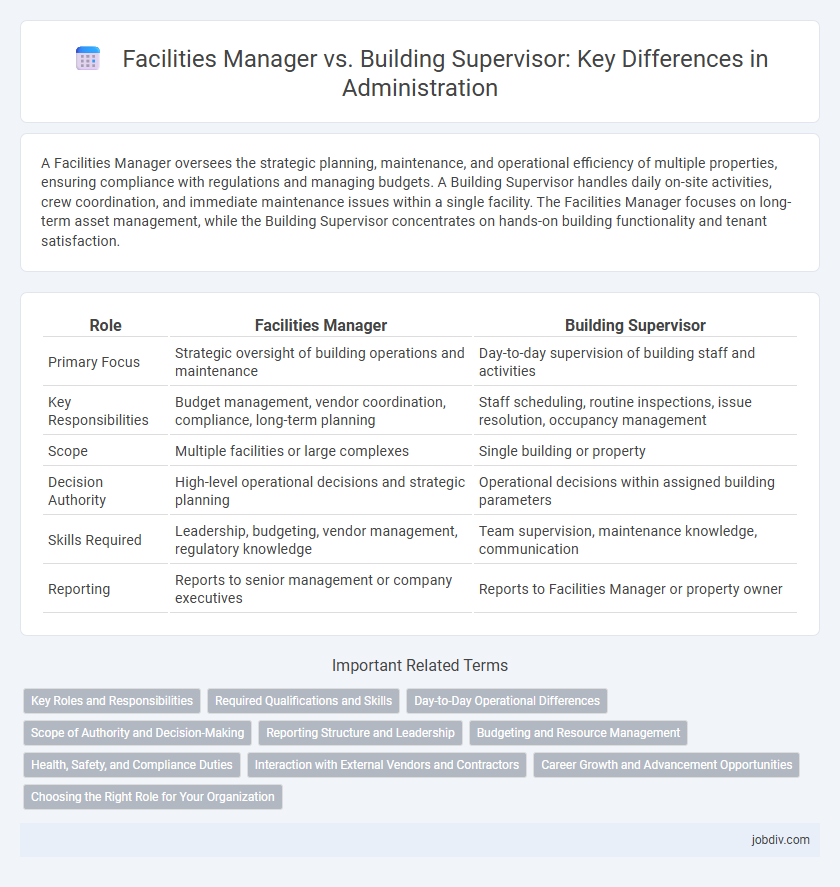A Facilities Manager oversees the strategic planning, maintenance, and operational efficiency of multiple properties, ensuring compliance with regulations and managing budgets. A Building Supervisor handles daily on-site activities, crew coordination, and immediate maintenance issues within a single facility. The Facilities Manager focuses on long-term asset management, while the Building Supervisor concentrates on hands-on building functionality and tenant satisfaction.
Table of Comparison
| Role | Facilities Manager | Building Supervisor |
|---|---|---|
| Primary Focus | Strategic oversight of building operations and maintenance | Day-to-day supervision of building staff and activities |
| Key Responsibilities | Budget management, vendor coordination, compliance, long-term planning | Staff scheduling, routine inspections, issue resolution, occupancy management |
| Scope | Multiple facilities or large complexes | Single building or property |
| Decision Authority | High-level operational decisions and strategic planning | Operational decisions within assigned building parameters |
| Skills Required | Leadership, budgeting, vendor management, regulatory knowledge | Team supervision, maintenance knowledge, communication |
| Reporting | Reports to senior management or company executives | Reports to Facilities Manager or property owner |
Key Roles and Responsibilities
Facilities Managers oversee the strategic planning, maintenance, and operational efficiency of building systems, ensuring compliance with safety regulations and managing budgets. Building Supervisors handle day-to-day activities like coordinating maintenance staff, monitoring building performance, and addressing tenant concerns. Both roles require expertise in facilities operations, but Facilities Managers focus on long-term planning and resource allocation, while Building Supervisors concentrate on immediate building upkeep and staff supervision.
Required Qualifications and Skills
A Facilities Manager typically requires a bachelor's degree in facilities management, engineering, or business administration along with certification such as Certified Facility Manager (CFM) for advanced expertise. Essential skills include strategic planning, budget management, and knowledge of building systems, sustainability, and compliance regulations. A Building Supervisor often needs a high school diploma or associate degree, relevant experience in building maintenance, and skills in team leadership, day-to-day operations oversight, and basic repair knowledge.
Day-to-Day Operational Differences
Facilities Managers oversee strategic planning, budgeting, and long-term maintenance projects across multiple buildings, ensuring compliance with safety regulations and coordinating vendor contracts. Building Supervisors handle daily operational tasks such as supervising maintenance staff, conducting routine inspections, and addressing immediate repair needs within a specific facility. While Facilities Managers focus on broad facility performance and resource allocation, Building Supervisors ensure smooth day-to-day building operations and occupant satisfaction.
Scope of Authority and Decision-Making
A Facilities Manager oversees comprehensive operational functions including maintenance, budgeting, vendor management, and strategic planning, exercising broad decision-making authority across multiple sites. In contrast, a Building Supervisor focuses on day-to-day building operations, ensuring safety compliance and managing onsite staff with limited decision-making scope. The Facilities Manager typically holds higher organizational responsibility, authorizing significant expenditures and policy implementation, whereas the Building Supervisor operates within predefined guidelines and reports to higher management.
Reporting Structure and Leadership
Facilities Managers typically report to senior management or directors and hold strategic leadership roles overseeing multiple buildings or sites. Building Supervisors often report directly to Facilities Managers or site managers, focusing on day-to-day operational leadership within a specific facility. This hierarchy ensures clear accountability, with Facilities Managers driving policy and long-term planning while Building Supervisors execute on-site management and staff coordination.
Budgeting and Resource Management
Facilities Managers oversee budgeting by developing long-term financial plans and allocating resources to optimize building operations, while Building Supervisors typically manage day-to-day expenses within predefined budgets. Facilities Managers analyze cost efficiency and forecast expenses for maintenance, utilities, and capital projects, ensuring sustainable resource utilization. Building Supervisors coordinate staff schedules and supplies, focusing on immediate operational needs and adhering strictly to budget constraints set by higher management.
Health, Safety, and Compliance Duties
Facilities Managers oversee comprehensive health, safety, and compliance programs, ensuring adherence to local regulations, risk assessments, and emergency preparedness plans for entire properties. Building Supervisors focus on daily operational safety checks, enforcing workplace health protocols, and reporting compliance issues to senior management. Both roles collaborate to maintain secure environments, but Facilities Managers hold broader strategic responsibility across multiple sites.
Interaction with External Vendors and Contractors
Facilities Managers coordinate with external vendors and contractors to oversee maintenance schedules, service quality, and contract negotiations, ensuring compliance with organizational standards. Building Supervisors primarily act as on-site liaisons, facilitating daily communication and addressing immediate operational issues with external service providers. Effective interaction in both roles enhances facility performance, vendor accountability, and timely resolution of building-related concerns.
Career Growth and Advancement Opportunities
Facilities Managers typically have broader responsibilities, overseeing multiple building systems and long-term operational strategies, which often lead to higher-level executive roles in corporate facility management or real estate development. Building Supervisors focus on day-to-day property maintenance and staff coordination, offering career growth within building operations or transitioning into Facilities Management roles with experience. Both positions provide pathways to senior management, but Facilities Managers generally experience faster advancement due to their strategic scope and involvement in budget and project planning.
Choosing the Right Role for Your Organization
Selecting between a Facilities Manager and a Building Supervisor depends on the organization's scope and operational needs; Facilities Managers oversee comprehensive maintenance, space management, and strategic planning, while Building Supervisors focus on daily building operations and staff coordination. An organization seeking long-term infrastructure planning and integration of multiple systems will benefit from a Facilities Manager's expertise. For businesses prioritizing immediate oversight of facility functionality and on-site issue resolution, a Building Supervisor offers targeted leadership.
Facilities Manager vs Building Supervisor Infographic

 jobdiv.com
jobdiv.com